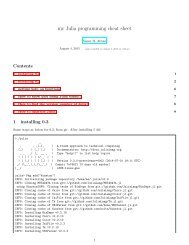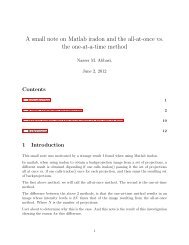Create successful ePaper yourself
Turn your PDF publications into a flip-book with our unique Google optimized e-Paper software.
at t = t 1<br />
˙u (t 1 ) = −ξωe −ξωt 1<br />
(A cos ω d t 1 + B sin ω d t 1 ) + e −ξωt 1<br />
(−Aω d sin ω d t 1 + ω d B cos ω d t 1 )<br />
u st<br />
+ ϖ<br />
cos (ϖt 1 − θ) (3)<br />
√(1 − r 2 ) 2 + (2ξr) 2<br />
Now for t > t 1 the equation becomes<br />
which has the solution<br />
where A = u (t 1 ) and B = ˙u(t 1)+u(t 1 )ξω<br />
ω d<br />
mü + c ˙u + ku = 0<br />
u = e −ξωt (A cos ω d t + B sin ω d t)<br />
critically damped with sin impulse ξ = c<br />
c r<br />
= 1 For t ≤ t 1 Initial conditions are u (0) = u 0 and ˙u (0) = v 0<br />
then the solution is from above<br />
u (t) = (A + Bt) e −ωt u st<br />
+<br />
sin (ϖt − θ) (1)<br />
√(1 − r 2 ) 2 + (2r) 2<br />
Where tan θ =<br />
cϖ<br />
k−mϖ 2<br />
= 2ξr<br />
1−r 2 . A, B are found from initial conditions<br />
A = u 0 +<br />
u st<br />
√(1 − r 2 ) 2 + (2r) 2 sin θ<br />
B = v 0 + u 0 ω +<br />
u st<br />
√(1 − r 2 ) 2 + (2r) 2 (ω sin θ − ϖ cos θ)<br />
For t > t 1 the solution is<br />
To find u (t 1 ) , from Eq(1)<br />
u (t) = (u (t 1 ) + ( ˙u (t 1 ) + u (t 1 ) ω) t) e −ωt (2)<br />
u (t 1 ) = (A + Bt) e −ωt 1<br />
+<br />
u st<br />
√(1 − r 2 ) 2 + (2r) 2 sin (ϖt 1 − θ)<br />
taking derivative of (1) gives<br />
˙u (t) = −ω (A + Bt) e −ωt + Be −ωt + ϖ<br />
sin (ϖt − θ) (3)<br />
√(1 − r 2 ) 2 + (2r) 2<br />
u st<br />
at t = t 1<br />
˙u (t 1 ) = −ω (A + Bt 1 ) e −ωt 1<br />
+ Be −ωt 1<br />
+ ϖ<br />
sin (ϖt 1 − θ) (4)<br />
√(1 − r 2 ) 2 + (2r) 2<br />
u st<br />
Hence Eq (2) can now be evaluated using Eq(3,4)<br />
over-damped with sin impulse ξ = c<br />
c r<br />
> 1 For t ≤ t 1 Initial conditions are u (0) = u 0 and ˙u (0) = v 0 then<br />
the solution is<br />
u = Ae p1t + Be p2t u st<br />
+<br />
sin (ϖt − θ)<br />
√(1 − r 2 ) 2 + (2ξr) 2<br />
where tan θ = 2ξr<br />
1−r 2 (make sure you use correct quadrant, see not above on arctan) and<br />
p 1 = − c<br />
√ ( c<br />
) 2<br />
2m + k −<br />
2m m<br />
= −ωξ + ω √ ξ 2 − 1<br />
47





